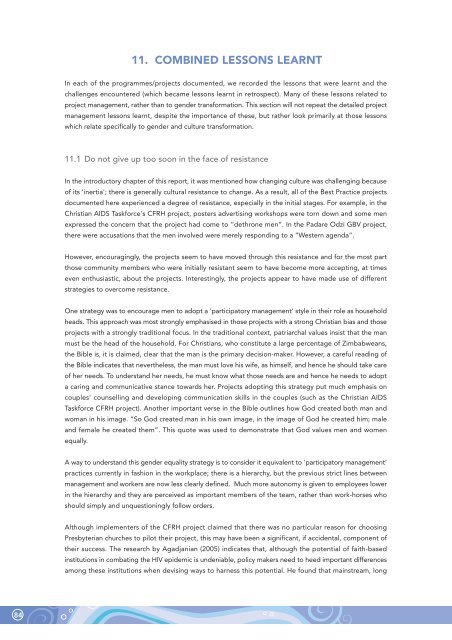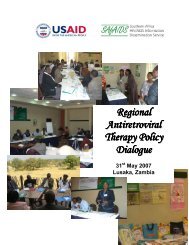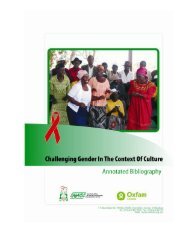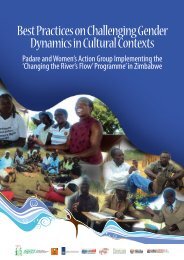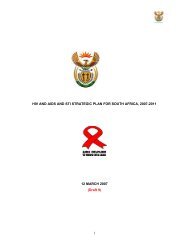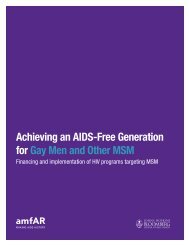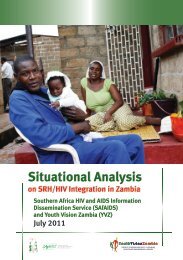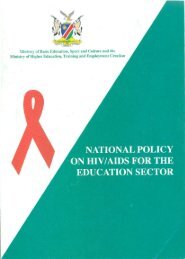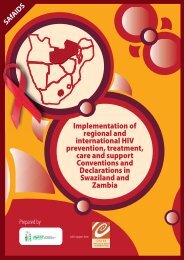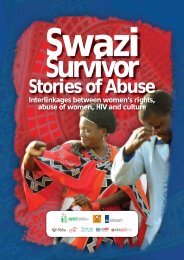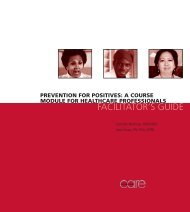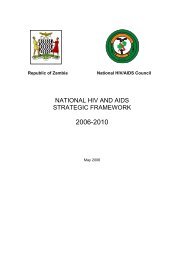Zimbabwean stories of "Best Practice" - SAfAIDS
Zimbabwean stories of "Best Practice" - SAfAIDS
Zimbabwean stories of "Best Practice" - SAfAIDS
You also want an ePaper? Increase the reach of your titles
YUMPU automatically turns print PDFs into web optimized ePapers that Google loves.
11. COMBINED LESSONS LEARNTIn each <strong>of</strong> the programmes/projects documented, we recorded the lessons that were learnt and thechallenges encountered (which became lessons learnt in retrospect). Many <strong>of</strong> these lessons related toproject management, rather than to gender transformation. This section will not repeat the detailed projectmanagement lessons learnt, despite the importance <strong>of</strong> these, but rather look primarily at those lessonswhich relate specifically to gender and culture transformation.11.1 Do not give up too soon in the face <strong>of</strong> resistanceIn the introductory chapter <strong>of</strong> this report, it was mentioned how changing culture was challenging because<strong>of</strong> its 'inertia'; there is generally cultural resistance to change. As a result, all <strong>of</strong> the <strong>Best</strong> Practice projectsdocumented here experienced a degree <strong>of</strong> resistance, especially in the initial stages. For example, in theChristian AIDS Taskforce's CFRH project, posters advertising workshops were torn down and some menexpressed the concern that the project had come to “dethrone men”. In the Padare Odzi GBV project,there were accusations that the men involved were merely responding to a “Western agenda”.However, encouragingly, the projects seem to have moved through this resistance and for the most partthose community members who were initially resistant seem to have become more accepting, at timeseven enthusiastic, about the projects. Interestingly, the projects appear to have made use <strong>of</strong> differentstrategies to overcome resistance.One strategy was to encourage men to adopt a 'participatory management' style in their role as householdheads. This approach was most strongly emphasised in those projects with a strong Christian bias and thoseprojects with a strongly traditional focus. In the traditional context, patriarchal values insist that the manmust be the head <strong>of</strong> the household. For Christians, who constitute a large percentage <strong>of</strong> <strong>Zimbabwean</strong>s,the Bible is, it is claimed, clear that the man is the primary decision-maker. However, a careful reading <strong>of</strong>the Bible indicates that nevertheless, the man must love his wife, as himself, and hence he should take care<strong>of</strong> her needs. To understand her needs, he must know what those needs are and hence he needs to adopta caring and communicative stance towards her. Projects adopting this strategy put much emphasis oncouples' counselling and developing communication skills in the couples (such as the Christian AIDSTaskforce CFRH project). Another important verse in the Bible outlines how God created both man andwoman in his image. “So God created man in his own image, in the image <strong>of</strong> God he created him; maleand female he created them”. This quote was used to demonstrate that God values men and womenequally.A way to understand this gender equality strategy is to consider it equivalent to 'participatory management'practices currently in fashion in the workplace; there is a hierarchy, but the previous strict lines betweenmanagement and workers are now less clearly defined. Much more autonomy is given to employees lowerin the hierarchy and they are perceived as important members <strong>of</strong> the team, rather than work-horses whoshould simply and unquestioningly follow orders.Although implementers <strong>of</strong> the CFRH project claimed that there was no particular reason for choosingPresbyterian churches to pilot their project, this may have been a significant, if accidental, component <strong>of</strong>their success. The research by Agadjanian (2005) indicates that, although the potential <strong>of</strong> faith-basedinstitutions in combating the HIV epidemic is undeniable, policy makers need to heed important differencesamong these institutions when devising ways to harness this potential. He found that mainstream, long84


